General guidelines for choosing that everyone should know
Summarizing the comparative characteristics of various types of heating devices, the following main points can be distinguished:
- For a centralized open heating network, present in high-rise buildings, like many years ago, a cast-iron radiator remains the best option. It is resistant to the poor quality water circulating through our pipelines and will last for many years. "Accordion" will withstand pressure drops and water shocks, while effectively heating the air in the room. The low price of this type of heating device makes it quite affordable for everyone. However, the high inertness of cast iron will not allow combining such a radiator with a thermostat.
- A good alternative to a cast iron battery in apartment buildings is a bimetallic one based on steel with aluminum or copper. Steel has enough rigidity and corrosion resistance to withstand water hammer and unfavorable water chemistry in the central system, while aluminum or copper compensates for the less than outstanding heat dissipation of steel. However, the high cost does not allow us to say that this will be the best option.
- For closed heating systems present in private houses, it is usually easier to choose batteries - there is no overpressure in the heating system, and the water is treated before entering the pipeline. Therefore, the best type of heating device for a home is aluminum. Its price is affordable, the design is good, and the heat dissipation is high. The low inertness of this will allow it to be used in conjunction with a thermoregulation system.
- A good alternative to aluminum batteries in conditions of autonomous heating is steel radiators. Having a lower heat transfer than aluminum, steel heating devices have many advantages - low weight, low inertia, nice design, attractive price.
- Steel and aluminum batteries are produced primed along the inner plane of the heating element to prevent corrosion from an aggressive coolant environment. Scale and rust particles present in the coolant of open heating systems lead to mechanical destruction of the primer layer inside the devices, therefore, manufacturers recommend using them in closed heating systems of private houses. A copper radiator can be a good option for open centralized systems, but not everyone will be pleased with its cost.
Features of heating in a private house
Not only the comfort of living in it in winter, but also the amount of material costs associated with heating and maintaining the house depends on how efficiently and competently the calculation will be made, the selection and installation of heating devices is made. Therefore, first you need to choose the type of heating system that will be installed in it. She may be:
In the first case, the premises are heated by means of stove heaters or special electrical devices. which include infrared heaters.
Stove heating is the cheapest and easiest heating method, however, it also has many disadvantages, such as:
- Long warm-up period.
- Low heat transfer coefficient compared to other energy sources.
- A high percentage of heat loss (most of the heat with such heating goes into the chimney).
Electric and infrared devices are a more progressive way of heating private houses, but their biggest drawback is their high cost and inaccessibility for a larger number of consumers, as well as the high costs associated with their operation.
A more popular and widespread option for heating a private house is water-type heating systems.in which the heating of the premises is carried out by heating the water moving along the radiators and pipes.
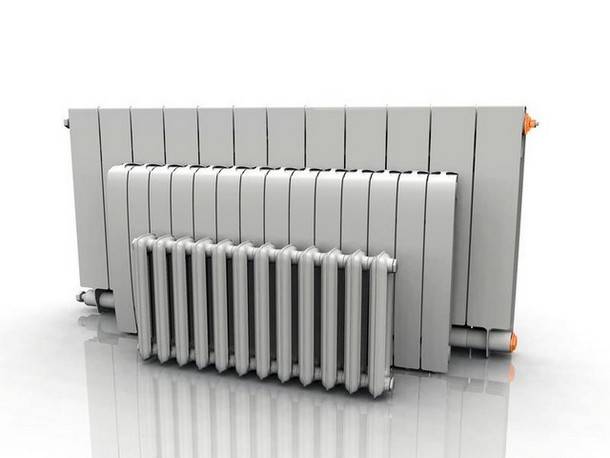 Installation of radiators is the best option for use as a heating system in private houses.
Installation of radiators is the best option for use as a heating system in private houses.
Their advantages in a private house compared to a centralized system include:
- Low network pressure;
- Lack of the likelihood of water hammer;
- Limited and adjustable coolant temperature;
- The ability to control the acid-base balance of the coolant.
In addition, they are distinguished by ease of use, efficiency and economy.
What radiators are preferred for a private house
Having considered the described characteristics, we can draw conclusions about which radiators are more practical and better for heating a house.
- As a budget economical option, according to experts, steel panel models are perfect. They come in various shapes and sizes, and can be installed in a niche under a windowsill where they create a thermal curtain of cold air, or at the bottom of walls. They do not take up much space, are resistant to the effects of any coolant, including antifreeze.
- A more expensive option is steel tubular or cast iron prefabricated batteries. Modern models are distinguished by attractive design, do not require maintenance and painting, and are easy to clean. These types of batteries are resistant to rust and salt deposits. Their shape allows not only to heat the house, but also to dry things and shoes, which is a pleasant option for a summer cottage or a country house.
- The choice of wealthy people - bimetallic models with a long service life and increased heat transfer, corrosion resistance and good performance. Their installation removes the heating problem for many years, so the initial costs pay off over time.
- Prefabricated aluminum radiators can be used in autonomous heating systems only with appropriate water treatment or the use of high-quality antifreeze.
Features of heating in a private house
In country houses and cottages, the heating system is usually connected to the boiler and differs from centralized systems. The most important ones are:
- coolant pressure - it usually does not exceed 3 atm.;
- type and quality of the heat carrier.
Unlike centralized systems. in standalone. with the correct operation of the boiler. the likelihood of a water hammer is practically excluded. This feature, as well as the low pressure of the coolant, allows you to use almost any type of radiator without fear of destruction and leaks.
If water is used as a heat carrier, its quality can also affect the operating conditions of the radiators. In particular, hard water with a large amount of salts can cause sediment to form on the inner surface of the radiators, and, as a result, to narrowing the gap and deteriorating heat transfer.
The type of system - open or closed - is also important.
In an open system, oxygen dissolved in water is constantly present, which at elevated temperatures leads to rather active corrosion of some types of radiators.In closed systems with a membrane expansion tank, oxygen, during the initial heating of the coolant, is bound into insoluble compounds - metal oxides, after which corrosion stops before filling with fresh portions of water.
Also, in private heating systems, antifreezes are sometimes used that do not freeze at subzero temperatures. Their use allows stopping the boiler in winter, which is convenient for country cottages and houses used for periodic residence. Not all types of radiators can be used in antifreeze systems.
Which heating radiator to choose
The design also plays an important role as it is exposed to water hammer from time to time. This means that there is a high risk of leaks in the weak areas, which are always the joints. For this reason, panel structures last longer. When you need to choose a radiator, the thickness of the metal is also taken into account, since fine debris often circulates in the system. It is better to choose a heating battery with average characteristics if there is no reliable information about the quality of the coolant and the parameters of the boiler equipment.
For apartment
Disadvantages of district heating:
- risk of water hammer;
- the presence of sludge in the communications, which penetrates the system along with the coolant, which leads to thinning of the metal from the inside;
- temperature instability.

It is possible to decide which batteries are better to put in an apartment, taking into account the following parameters:
- The rated pressure must be higher than the working, test pressure. This reduces the likelihood of deformation and, as a result, damage to the radiator. Standard pressure indicators for 5-storey buildings: from 5 to 8 atm. In multi-storey buildings, the coolant pressure is set in the range of 12-15 atm.
- Wear resistance of the radiator. Due to the resistance to negative external factors, the service life of the device is extended.
- The thickness of the walls of the batteries must be substantial to avoid abrasion of the metal under the regular influence of internal sludge.
- So that the radiator in the house does not collapse upon constant contact with the coolant containing chemically active elements, it is recommended to choose products with a protective coating on the inner walls. The use of a chemically neutral material in the manufacture of internal structural elements will also solve this problem.
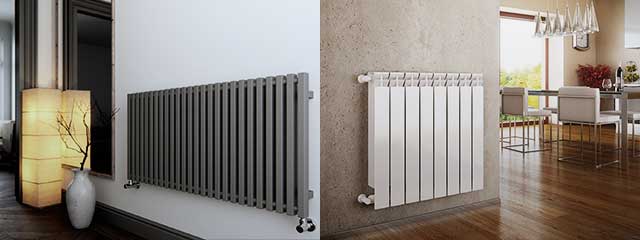
Taking into account the above parameters, steel radiators are less suitable for arranging a heating system in an apartment. This is due to the fact that such products do not withstand the limiting pressure values. Despite the high thermal conductivity, aluminum counterparts are also not suitable for apartment buildings. The fact is that they are deformed under the influence of water hammer.
In addition, aluminum radiators are characterized by mediocre properties: they do not withstand the destructive effects of chemical compounds present in the coolant; deformed under the influence of pressure limits. Bimetallic analogs are strong, durable, withstand high temperatures, and are less susceptible to corrosion and chemical reagents. However, the cost of such products is high.
> Cast iron batteries are also suitable for the heating system of an apartment building. This is due to the large thickness of the metal, corrosion resistance, high thermal inertia and thermal conductivity. In addition, in terms of external characteristics, such radiators are not inferior to their counterparts.
For a private house
Autonomous heating system parameters:
- low pressure;
- there are no intense water hammers.

If you control the quality of the coolant, you can use different types of batteries to heat the house. For this reason, the main criterion when buying is the thermal conductivity index, as well as the price-quality ratio of the product. Advantages of different types of radiators in relation to private housing:
- Steel panel batteries. Due to its large dimensions (width, height), they block a wide window opening in private houses. They differ in a sufficient indicator of thermal conductivity.
- Tubular steel batteries are similar in parameters to panel counterparts, but they are distinguished by an attractive appearance and a higher price. Steel appliances require regular maintenance. They are washed every 3 years.In addition, it is advisable to keep such products in a filled state to avoid rusting of the metal.
- Aluminum radiators are often chosen for their home. They are distinguished by their compactness, average pressure indicators, and high efficiency of the heat transfer process. However, you will have to constantly monitor the acidity level of the coolant.
- In all respects, bimetallic batteries are suitable for private houses too. Considering that it is necessary to install a large number of radiators in your home, the costs will increase significantly, since the cost of bimetallic devices is quite high.
- Cast iron batteries are also suitable for private housing. Their main advantage is inertia, which helps to reduce gas costs.
2> Cast iron
Such radiators began to be installed in homes more than a century ago, during the time of tsarist Russia. For 100 years, these batteries continue to be in demand, providing high-quality heating of premises. Even today, in houses built during the Soviet period, cast iron batteries with more than 50 years of service life are quite common.
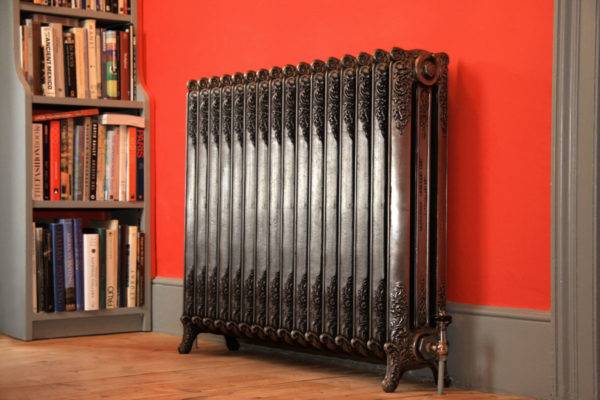
Cast iron heating battery.
The following positive qualities brought them popularity:
- Long period of work (radiators can function for tens of years);
- High level of heat transfer (degree of heating - up to 130 ° C, can stay hot for 5-6 hours);
- Good durability (batteries are able to withstand internal high pressure, are immune to mechanical stress);
- Work with any quality of the heat carrier (no need to install a filter on the heating system);
- Anti-corrosion resistance (under the influence of condensation and temperature extremes, as evidenced by the smooth operation in old houses).

However, cast-iron radiators have their drawbacks, due to which they are gradually replaced by more modern types of devices:
- Large dimensions. Due to their size, it is difficult to transport, install and maintain.
- Low thermal conductivity due to the massiveness of the metal and its porous surface. To achieve a high level of heat transfer, the temperature of the heating medium must be 70-80 ° C.
- Systematic care is required. Batteries need to be cleaned and painted regularly.
- It takes a lot of space to accommodate.
- Good fittings are needed for a secure fit.
Advice! To increase the heat transfer of cast iron batteries, they should be washed about once every two years from accumulated rust and particles of small debris.

Cast iron radiator Konner "Legend"
In addition, cast-iron radiators are not distinguished by the most attractive appearance, which is why the interior looks inharmonious. If the design of the room is important to you, then you will have to purchase decorative elements in the form of partitions or fences, but not every owner will want to put additional decorations. Then how to choose the right cast iron heating radiators for a private house in order to create a harmonious environment? Take a look at the dedicated lines of some German or French manufacturers developing original design pieces for themed interior styles. Such radiators will become a real decoration of the environment, but not everyone can afford them due to the high cost.
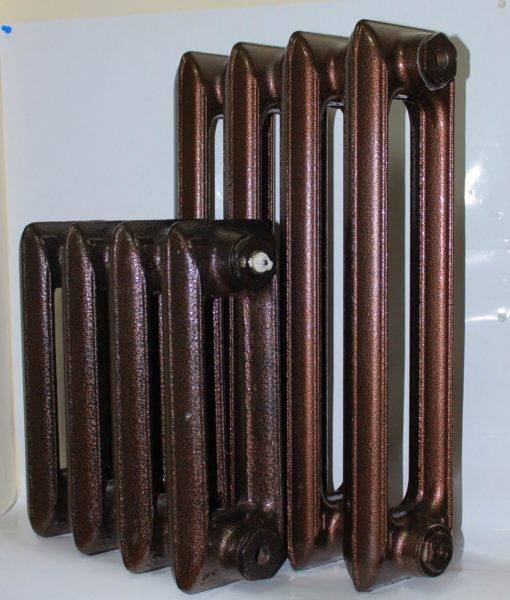
Cast iron radiator MS - 140
Among the popular manufacturers of cast iron batteries, it is worth highlighting the Chinese firms Tokio or KONNER, as well as the Russian version - MS-140.
Types of radiators
There are several types of designs:
- Sectional.
- Panel.
- Tubular.
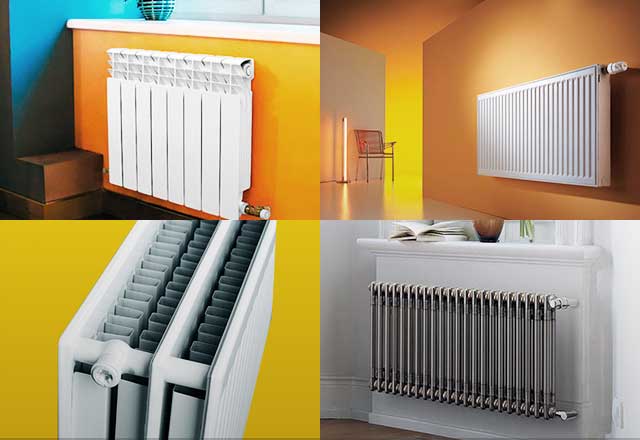
The best heating radiators are those with the largest usable heat transfer area. Such models will warm up the air in the room faster.Batteries of simpler configuration are characterized by low efficiency, but the increased intensity of heat transfer from the material from which they are made partially compensates for this disadvantage. Enhances the properties of devices and a combination of two different metals. Such radiators are the most efficient.
Bimetallic
These are expensive devices. They are characterized by a high wear resistance limit. The destructive pressure for them is the pressure corresponding to 100 atm, which exceeds the operating indicator of this parameter (20-50 atm). The service life of such radiators will be long. In terms of their characteristics, they surpass their counterparts from other metals. Available designs:
- steel + aluminum;
- steel + copper.
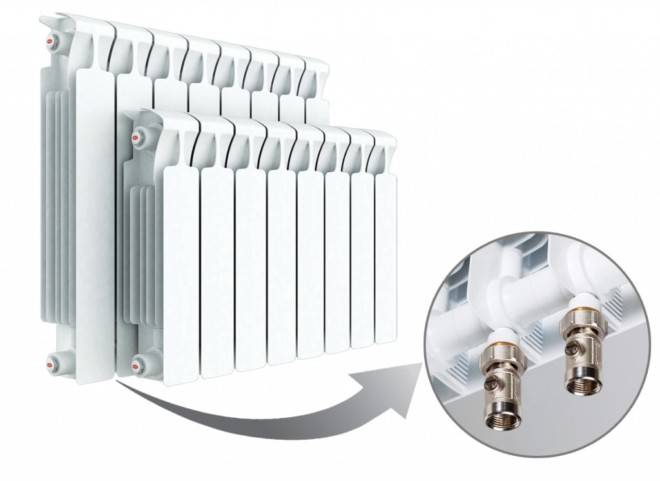
In the first variant, the weak link is the aluminum elements. However, they do not come into contact with the coolant, which means they will not corrode and water hammer.
Aluminum
Such devices are divided into two groups:
- cast;
- made by extrusion (extrusion).

Aluminum radiators are characterized by high thermal conductivity, which makes them the most efficient. Additionally, a large number of ribs and sections contributes to increasing the functionality of such devices. The advantages include compact dimensions, because the small dimensions of the device are compensated for by high thermal conductivity and a large heat transfer surface area. The main disadvantage is susceptibility to the rusting process.
Cast iron
This is a traditional version of batteries, it is more often found in industrial, public purpose facilities, in private homes. Advantages of cast iron radiators:
- long period of operation;
- high heat transfer rate, inertia, which allows you to keep heat for a long time;
- resistance to corrosion formation;
- immunity to water hammer;
- no requirements for the quality of the coolant.
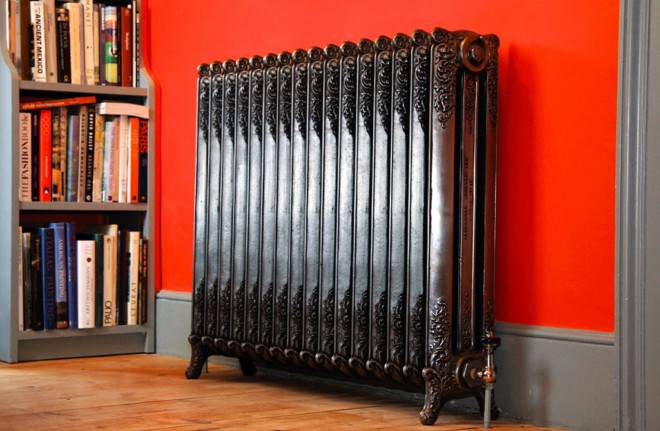
The main disadvantage is its heavy weight. The devices are difficult to transport, and their maintenance is difficult.
Steel
Low-carbon steel is used in the manufacture. The devices are coated with powder paint. Steel structures are divided into groups:
- tubular;
- panel;
- sectional (typesetting).

The second of the options outwardly resembles cast iron counterparts, but in this case, the sections are connected to each other not by intersection nipples, but by welding seams. Panel batteries hold less water. Tubular counterparts represent a high price category. In terms of wear resistance, this option is similar to sectional ones, however, it is characterized by a small metal thickness (1 mm).
Copper
Such radiators are distinguished by a high rate of thermal conductivity, which means that they warm up the room quickly. They are designed in such a way that, with a minimum volume of coolant, they are able to provide the required level of efficiency of the heating system. For this reason, copper batteries are preferable for applications where it is desirable to reduce the cost of water consumption. Copper radiators are also used in apartment buildings. The advantages include corrosion resistance. In addition, the metal does not become thinner during operation. However, the price of such products is high.

Electrical
Devices of this type do not need a coolant supply. They function from the mains voltage, are called heaters and are divided into groups:
- oil;
- infrared;
- convectors.

The first of the options resembles a traditional battery: it has the semblance of sections or is made in the form of a panel structure. Infrared models are the most economical, characterized by high efficiency due to heating of surrounding objects.Convectors contribute to an increase in air temperature, which is due to the presence of a metal heating element in the structure.
Copper radiator for home heating system
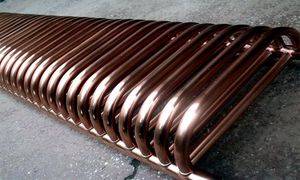
radiators provide a fairly effective heating of rooms
With a minimal level of inertia, the copper battery provides the fastest heating of rooms in the house. Such radiators contain a minimum volume of the coolant, which allows them to warm up in a few minutes. Due to such a small volume of water, there is no need to heat a large amount of coolant, which affects the efficiency of the autonomous heating system of a private house, which cannot be achieved in the case of installing cast-iron batteries.
Copper is a fairly plastic and corrosion-resistant material that does not wear out under the influence of a low-quality coolant, as is the case with an aluminum analogue. And thanks to its high efficiency at minimum temperatures, a copper battery could be the best choice for any heating system. But due to the very high cost of such a product, it has not found wide distribution among consumers.
6 How to choose a heating radiator depending on the power
How to choose the right heating radiators for a private house? Here, not only the appearance of the products is important, but also the power - when buying a device, you need to find out how much power is needed to heat the system. This is not as difficult as it might seem at first. So, heating one square meter in a room with a ceiling height of three meters and one window requires about 100 watts. Then simply multiply the area of the room by 100 W. And to make the calculations even more accurate, do not forget:
- if the room has one window and two external walls, add about 20% more to the calculated power;
- if there are two windows and two external walls, add about 25-30%;
- when the window faces the northern part, it is worth adding at least 10% to the calculations.
By doing these calculations, you can more accurately choose the right radiator for your home. And the power of the devices can always be seen in the documents - the "passport" of the device
By the way, it doesn't matter what kind of radiators you decide to choose for installation in a private house, if you install them incorrectly, they will decorate your home, but will not provide the necessary heat to heat the room.
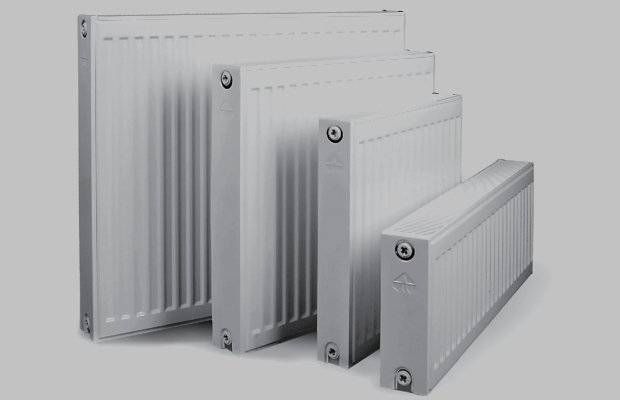
The choice of radiators for a country house
Let's look at where to mount radiators - this information will definitely be useful to you when you create a heating scheme. So, batteries should be placed under light openings - windows. This place always has the most heat losses, even if you have modern double-glazed windows installed. A radiator placed under the window will warm the air around it. After that, the heated air rises up and creates a curtain in front of the window, preventing the penetration of cold into the room.
When choosing which heating radiators are best purchased for a private house, do not forget about the importance of the length of the devices - it should correspond to the width of the window opening. In extreme cases, the length should be at least 50% of the window width. In a corner room, it is worth placing 1–2 additional devices along the outer walls exposed to cold air
If you are going to install heating risers, mount them in the corners, which will ensure their warming up and avoid the likelihood of blackening of the walls and the appearance of mold in them
In a corner room, it is worth placing 1–2 additional devices along the outer walls that are exposed to cold air. If you are going to install heating risers, mount them in the corners, which will ensure their warming up and avoid the likelihood of blackening of the walls and the appearance of mold in them.
And do not forget that access to batteries must be open. Many owners of private houses cover heating radiators with sheets of drywall, which is undesirable - this will complicate the process of cleaning and repairing devices, if necessary. In addition, the use of such a fence will lead to a revision of earlier calculations for capacity.
We told you how and which radiators are best to choose for installation in a private house. Now you know that when buying devices, you need to take into account the quality of the water in the pipes, the power of the devices, their appearance and even the ability to install on fragile partitions, if necessary.
Conclusion
So, now we can answer the question, which radiator is better. Everything will depend on where you live. This refers to an apartment building or a private house. If you live in an apartment, then choose those radiators that can cope with a coolant pressure of at least 12 atmospheres. The rest can be used in private homes.
If you are on a budget, then choose budget options. For example, cast iron counterparts. If you want to create an unusual design in the room, take aluminum or bimetallic batteries. After reading this article, you are already becoming a specialist. In any case, you can no longer be deceived.
Read on:
The question of choice: convector or oil heater - which is better?
What are the best heating batteries?
Choosing panel heating radiators, which are better for a private house
We figure out which radiators are better: bimetallic or aluminum
